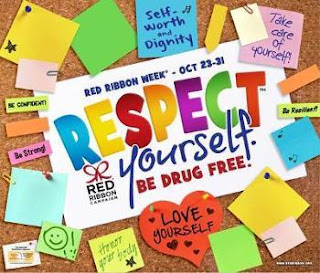RED RIBBON WEEK
This week the Junior High is celebrating Red Ribbon Week! Red Ribbon Week is a week of drug, alcohol, and violence prevention awareness. Every day on the announcements there will be interesting drug facts, and at lunch all the students have the opportunity to wrtie their "anti-drug" hands that will be hung all over the school. In addition, the entire school is encouraged to WEAR RED THIS THURSDAY!
This is a great opportunity to talk to your student about the dangers of drugs and alcohol. Here is the latest "TEACHable Moment" from the Drug Free Action Alliance. You can subscribe to this information on their website!
Know! The Impact of Marijuana on
Adolescents
“We are the New Americana, getting high on legal marijuana,” are the
lyrics to a popular new song by 21-year-old singer/songwriter ‘Halsey.’ Her
song reflects the unfortunate reality of the world our children are growing up
in, as marijuana becomes not only legal, but socially acceptable in more and
more states. It would be only natural for young people to assume that if all
these adults have fought for or are fighting for marijuana to be legalized, then
the drug itself must be pretty harmless.
This assumption is incorrect and dangerous. While marijuana use is
risky for people of all ages, it is especially hazardous for youth.
Here’s
why:
Marijuana impacts the developing adolescent brain:
- Studies show that chronic (and sometimes casual) marijuana use during adolescence can actually change the physical shape, volume and density of a person’s brain, negatively impacting learning and memory. The severity of such brain abnormalities is shown to increase as frequency of use increases.
- Heavy use of marijuana during adolescence may also reduce a person’s IQ by as much as 8 points. A loss of 8 points could drop a person of average intelligence into the lowest third of the intelligence range.
Marijuana impacts school performance:
- Research consistently shows that marijuana users earn lower grades, are more likely to skip classes, have higher incidences of school suspension/expulsion and higher dropout rates, and are subsequently more likely in adulthood to experience unemployment, social welfare dependence and dissatisfaction in quality of life.
Marijuana impacts health and safety:
- Marijuana use has the potential to increase heart rate, cause lung and breathing problems, and is linked to anxiety, depression and suicidal thoughts among youth.
- Marijuana affects a person’s coordination, balance, reaction time, alertness and ability to concentrate – increasing one’s risk for accidental injury and death.
- Because the adolescent brain has not yet matured, many young people have a tendency to act on impulse, without regard for risk. Adding marijuana to the mix only increases the likelihood of poor decision-making, including engaging in risky sexual behaviors, getting into a car with an impaired driver, or taking part in a criminal act.
If the risks of marijuana continue to be downplayed by adults, there
is
a greater likelihood of more youth, including our sons and
daughters, giving this drug a try. Young people must be made aware that
marijuana is not harmless; that use of this drug causes people to think and
behave differently; that marijuana negatively impacts brain function,
intelligence, school performance and health and safety; and that marijuana use
not only threatens success in the present, but jeopardizes a hopeful
future.
For more information, visit Drug Free Action Alliance’s Marijuana
Resource page.
Sources: Meier et al. (2012). Persistent cannabis users
show neuropsychological decline from childhood to midlife. Proceedings of
the National Academy of Sciences. Neurology Advisor: Marijuana-Related Emergency
Department Visits on the Rise, December 17, 2014. National Institute on Drug
Abuse: Marijuana – Selected Effects on the Brain, Body & Behavior. Rocky
Mountain HIDTA Report: Volume 2, 2014.




Comments
Post a Comment